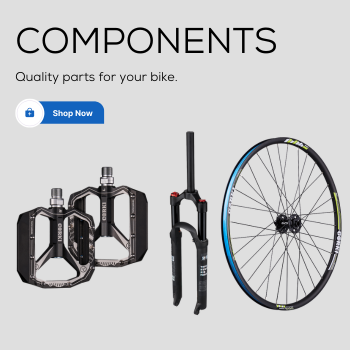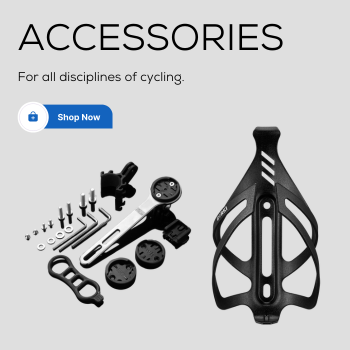
Why You Need Titanium Bike Pedals?
In the biking world, every component plays a crucial role in your overall riding experience, and today, we're here to spotlight a game-changing component – titanium bike pedals.
In this guide, we'll delve into why titanium bike pedals should be your next bicycle component investment. And we'll cover the following topic in detail:
- What Are Titanium Bike Pedals?
- Is It Worth Upgrading Your Bike Pedals?
- Pros and Con of Titanium Bike Pedals
- Is a Titanium Bike Pedal Right for You?
- Quick Installation Tips
What Are Titanium Bike Pedals?
In the bike industry, most titanium bike pedals aren't made of 100% titanium. Only the pedal axle (AKA spindle) is made of titanium. The platform is usually made of aluminum. Nevertheless, if you do some research, you will find most titanium pedals are built like this. This dual pairing of materials gives a tremendous overall pedal.

Titanium is known for its perfect blend of lightweight design, durability, and strength. Titanium bike pedals offer improved performance while also saving weight. For durability, titanium bike pedals last longer than other materials, such as plastic or all aluminum pedals
Is It Worth Upgrading Your Bike Pedals?
Before upgrading, you need to look at your riding habits and goals. These are some things to consider.
1. Terrain: If you mostly ride on smooth roads and have a casual style, you probably don't need to upgrade. It might not be worth the cost. But suppose you often go riding on the local trails. In that case, upgrading your pedals can improve your performance and make your pedals last longer.
2. Riding Conditions: Should you frequently venture onto local trails, improved pedals can boost performance, especially in wet conditions where rust-resistant titanium pedals shine.
3. Old Pedals: If your current pedals are high quality, hold off on immediate upgrades, but keep titanium pedals in mind for future enhancements.
Pros and Con of Titanium Bike Pedals
After understanding the basics of titanium bike pedals, we'll examine their advantages and disadvantages in detail. Here are the reasons why you should consider choosing titanium bike pedals.
Pros
1. Lightweight
Titanium is a very light material, making it an ideal bike pedal choice. Take the Corki TOPO Titanium MTB Pedals as an example. A pair only weighs 212g, half the weight of aluminum pedals of the same size. We all know every gram counts in extreme downhill MTB conditions. Every competitive biker wants pedals that let them move their bike quickly and easily. Lighter bikes mean less fatigue, allowing you to ride longer and perform better. So, titanium pedals can greatly reduce your bike's overall weight.
2. Durability
Titanium is a highly robust and durable material known for its low density and impressive strength-to-weight ratio. Pedals made from titanium are suitable for all types of riding, ranging from casual cruising to all-mountain free-riding. They are designed to tackle even the toughest terrains and conquer harsh conditions. With the support of one of the strongest metals in the world, every terrain is possible to conquer.
3. Corrosion Resistance
Titanium is a highly durable metal that doesn't rust or degrade over time, even in wet environments. Rust acts like a cancer, slowly eating away at the affected component and damaging your crank arms. However, titanium has an oxidized surface layer that can block oxygen and other chemicals from further corroding the metal. This property of titanium makes it a long-lasting material that doesn't require frequent replacements, saving you time and money.
Despite the many advantages mentioned earlier, the titanium bike pedal still has one major drawback.
Con
The price of titanium bike pedals is the only drawback. They cost more than those made of other materials, such as plastic or aluminum. But, if you consider it a decade investment, the cost is much more reasonable. Titanium bike pedals can last a long time and improve your riding experience. So, it might be a good future upgrade.

Is A Titanium Bike Pedal Right for You?
If you are wondering whether titanium bike pedals are the perfect fit for your cycling needs, we are here to help. We have listed a set of essential criteria that will assist you in determining if a titanium bike pedal is the ideal cycling companion for you. These criteria will be your trusted guide in making an informed decision.
1. Consider your riding style
Titanium bike pedals are good to upgrade if you often ride on rough terrain. They're reliable partners since they're durable enough to handle impact and rough conditions.
2. Look at the weight
If you want to increase your cycling speed and agility, titanium bike pedals are an excellent choice. The lightweight design of titanium pedals can significantly reduce the weight of your bike.
3. Think about your budget
Titanium bicycle pedals may cost more than other options, but investing in them is worthwhile if you want durable and long-lasting pedals.
4. Research Your Options
When it comes to titanium bike pedals, it's important to note that not all pedals are created equal. The quality and design can vary greatly among different brands, which can significantly affect the pedals' performance. For instance, the Corki Cycles TOPO titanium pedal is an all-around MTB flat pedal. Therefore, it's advisable to research various options and read reviews from other cyclists before making a decision.
5. Consider The Maintenance
Like all bike components, titanium bike pedals need regular maintenance. It's important to keep your pedals clean and well-oiled to make them function properly.
Quick Installation Tips
When installing titanium bike pedals, the process is the same as installing regular pedals. For a step-by-step video tutorial, you can consider subscribing to our YouTube channel.
You will need the following tools for installation:
- Pedal wrench or adjustable wrench
- Clean Rag
- Grease or lubricant
-
New pedals

Step 1: Prepare Your Bike
Before you start changing the pedals:
- Make sure that your bike is stable and secure.
- Shift the chain to the smallest chainring and cog to give you more room to work on the pedals.
Step 2: Remove the Old Pedals
To take off the left bike pedal, use either a special wrench for the pedals or an adjustable wrench. Remember that the left pedal has a reverse thread when you're on the bike. So, to loosen the pedal, turn the wrench counterclockwise. Then, repeat the procedure for the right pedal.
Step 3: Clean the Cranks
Before installing the new pedals, clean the threads of the crank arms to remove any dirt, debris, or old grease while checking the threads.
Step 4: Apply Lubricant or Grease
To ensure a smooth installation and prevent corrosion, apply a little bit of grease or lubricant to the threads. For this, you'll need high-quality assembly grease. Again, you don't need much but make sure the pedal threads are well-smeared.
Step 5: Install the New Pedals
Pedals are typically stamped with a small L (left) or R (right) around the thread. Some don't have a stamp, so you have to look at the threads to work it out. Normal thread for the right, reverse thread for the left. This means you apply the standard "rightie tightie, leftie loosie" rule to the right pedal. The opposite is true on the left side. When the pedal starts to thread in, instead of turning the pedal spanner around the axle, use it to rotate the entire crankset backward. This will quickly tighten them up!
Tips: Be careful not to overtighten the pedals on the crank arm, protecting the threads. When installing bike pedals, Park Tool recommends applying approximately 35-40 Newton meters (Nm) of torque.
Step 6: Test the Pedals
Finally, test the pedals to ensure they are securely fastened. Stand over the bike and press down on each pedal. Tighten the pedals again if they feel loose.
Conclusion
Riders who frequently ride in wet or difficult conditions can benefit greatly from titanium bike pedals. These pedals are strong, lightweight, and do not rust, making them an ideal companion for such conditions. Although they might be a bit more expensive than other options, the benefits they offer make them well worth the investment. We hope that this blog has provided you with a better understanding of titanium bike pedals.
Check out our own if you’re interested in a quality pair of titanium pedals.
Happy Riding!




